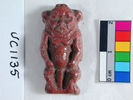The Alkonost is a legendary bird in Slavic mythology. It has the body of a bird with the head and chest of a woman. The name Alkonost came from the name of Greek demi-goddess Alcyone transformed by gods into a kingfisher. The Alkonost reproduces by laying eggs on the sea-shore then putting them into the water. The sea is then calm for six or seven days at which point the eggs hatch, bringing a storm. For the Russian Orthodox Church Alkonost personifies God's will. She lives in paradise but goes into our world to deliver a message. Her voice is so sweet that anybody hearing it can forget everything.
Among the most common images were the representations of the two legendary creatures, Sirin and Alkonost, depicted in Sirin, the Bird of Paradise and Alkonost, the Bird of Paradise. Loosely based on the stories about sirens, these half-women half-birds allegedly lived "in Indian lands" near Eden or around the Euphrates River, and sang their beautiful songs to the saints foretelling them future joys. However, for mortals the birds were dangerous. Hearing their sweet voices, men would forget everything on earth, follow them blindly, and die. To save themselves from the Sirin, people would shoot the cannon, ring the bells and make loud noises to scare the bird off.
read more
http://bestiary.us/alkonost.php


_Fisherman_And_The_Siren.jpg)

































